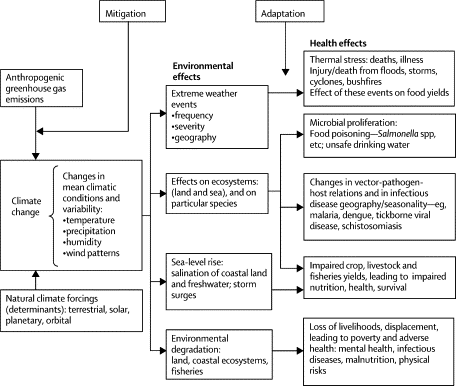April 6, 2019 – A friend of mine in the United States wrote me recently to describe a recent bout of pneumonia which he said was routed in climate change. It was an interesting observation and a telling point. If we are to manage the health of humans in the future then we should be shouldering the responsibility to address climate change.
How are the two so closely related?
When we change the environment we impact global ecosystems. And since we are participants in the global ecosystem we cannot help but be affected. The evidence tieing climate change to changes in human mortality is uncontested. The health effects are undeniable. Here is a summary of the pathways by which climate change impacts general population health.
It is heatwaves that are the easiest to relate to when talking about climate change and health. But other direct climate risks include an increase in physical hazards from extreme weather such as more intense storms, wildfires, and declines in air quality over cities as we use more fossil fuel energy to address extremes of either heat or cold.
Food Sources and Climate Change
Changes in climate alter food security with:
- declines in staple crop yields
- crop failures from drought or flooding
- disruption to fisheries from warming, and changes to acidity and oxygen-levels in lakes and oceans
- freshwater depletion
Rising Mortality Rates Associated with Climate Change
Mortality rates in the general population are tied to climate wherever you live in the world. If you live near the equator then your body is conditioned to a range from day to nighttime. Similarly, if you live in the temperate mid-latitudes your body is conditioned to the same variables. And in the Arctic, the same holds true as well. Atmospheric warming, however, is uneven and has some peculiar aspects to it. For instance, the Arctic under the influence of anthropogenic climate change is warming twice as fast as the mid-latitudes and equatorial regions of the planet. And one thing more, the biggest change isn’t so much in the daytime. It is nighttime temperatures where global warming is seen to be most significant.
The thermal stress from elevated nighttime temperatures is impacting more than just human populations. For nocturnal animals, the change is proving to be a significant shock disrupting many species. Some are migrating either to higher latitudes or higher elevations to escape nighttime heat.
In the tropics, even a small increase in daytime temperatures could prove lethal. This is becoming particularly noticeable in the Middle East, Central and South Asia, and Australia, where daytime highs have approached levels where being outside at the peak heat of the day could prove lethal. In these areas of the planet higher nighttime temperatures means little in the way of relief.
The other side to the temperature issue that accompanies global warming is the increasing swings in weather with prolonged intrusions of cold air coming from polar regions that no longer feature stable air masses for a number of reasons, the prime one being a dramatic loss of sea ice in the Arctic. The so-called polar vortices that have been descending with greater frequency into lower latitudes particularly in North America and Siberia produce increased levels of diseases like pneumonia, and influenza.
Epidemiological studies show the correlation between temperature and mortality with the elderly showing the greatest sensitivity because of declining thermoregulation as we age. Other population groups most sensitive to heat or cold include those with cardiovascular and chronic lung diseases.
Infectious Diseases and Climate Change
The pathogens that cause disease are themselves impacted by climate change whether it be warmer daytime and nighttime temperatures, increased precipitation, drought, and flooding. Cholera and salmonella thrive on higher temperatures. Disease-carrying insects commonly found in warmer climates, malaria, dengue, West Nile, chikungunya, Lyme, Zika, viral encephalitis, and others, are finding new habitats in areas where environmental conditions are changing. Even increased incidents of food poisoning are linked to the mean temperature rise in mid-latitude countries.
Fishing and Health Ramifications of Climate Change
Changes to ocean temperatures can be correlated to rising levels of mercury pollutant in the ocean. In studies done near the Faroe Islands concentrations of mercury increased levels of mercury in cod and whales by 3 to 5% for every 1 Celsius degree rise in ocean temperatures. Mercury-tainted fish impacts neurocognitive development in fetuses and in early childhood.
Then there is the shift in where fish are relocating themselves as the ocean surfaces and water column below continue to heat. Common commercial fishing areas are changing as many species migrate poleward in search of food sources such as zoo and phytoplankton.
Health Impact for Climate Refugees
As more populations get displaced because of extreme weather events we can expect the toll on health will climb. Already millions in Bangladesh are experiencing flood events from rising sea levels. The latest cyclone to hit the coast of Africa will likely cause a significant movement of population from current locations. Already the death toll from this one event is approaching a thousand with thousands more displaced or missing in Mozambique, Malawi, and Zimbabwe.
Cost if We Do Not Mitigate or Adapt?
In a 2017 study by the Natural Resources Defense Council, it looked at six events that had occurred, wildfire, hurricane season, flooding, West Nile Virus outbreak, an air pollution episode, and a heat wave and found the cost to human health to be over $14 billion USD.
In a 2014 study published in Environ Health Insights, researchers looked at the health cost impacts of climate change on 53 countries in Europe and surrounding areas and concluded that costs by 2050 would approach over 400 billion Euros annually. And some health estimates point to more than $1.4 trillion USD annually by the end of the century.
Managing Health and Climate Change Together
The challenge for governments and society is pretty clear. A concerted effort to mitigate the worst effects of climate change will mean healthier outcomes for the planet.
The longer we choose not to intervene aggressively by driving down carbon emissions, the more climate change will impact the health and safety of humanity and all other living things on the planet.
We are already seeing the consequences of inaction, and so we must act for a healthier humanity and planet.










